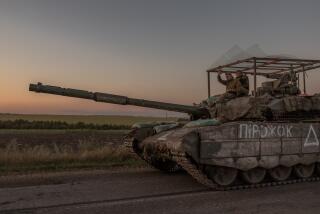U.S.-Ukraine Military Exercises Rub Russians the Wrong Way
- Share via
DONUZLAV, Ukraine — The original scenario was just a little too close to reality for comfort.
During this week’s Sea Breeze ’97 maneuvers, U.S. Marines were to deploy onto the plains surrounding this Ukrainian naval port to intervene in a mythical ethnic conflict in which rebels aided by a neighboring power sought to overthrow the government of “the orange country.”
But in ethnically diverse Crimea, whose Russian majority is still seething over loss of the peninsula to Ukraine in the Soviet Union’s 1991 breakup, the theoretical events were taken as a NATO warning to the Kremlin of what would happen if it sought to recover Crimea.
“It was really a case of no one stopping to think things through,” said one chagrined U.S. Marine officer who took part in planning the exercises.
Russian reaction to the exercises was so fierce that the script was changed to have the U.S. troops coming ashore not to quell ethnic unrest but to bring humanitarian aid after an earthquake.
The land-based segments of the exercises, which continue through Sunday, were also relocated to the Ukrainian mainland to escape the wrath of Crimean Russians.
As many as 3,000 demonstrators opposed to what they saw as a show of force against Russia took to the streets here and in nearby Yevpatoriya each day to denounce “American imperialism” and perceived threats from the North Atlantic Treaty Organization.
Crimea had been part of Russia since the late 18th century, but Ukrainian-born Soviet leader Nikita S. Khrushchev made it part of his native republic in 1954. The move meant little until the Soviet Union collapsed and Crimea became part of independent Ukraine.
Moscow’s anger over the exercises has abated little despite the changes made to Sea Breeze, fueling concern that what was intended to enhance Ukraine’s military preparedness may actually hurt security by provoking new problems with Russia.
“Military exercises are a matter of the internal affairs of any country, but we perfectly well understood what was meant by the ‘orange country’ and the ‘mass unrest’ that needed to be quelled,” said Capt. Andrei Grachev, spokesman for the Russian Black Sea Fleet. “We have to ask ourselves in whose interest it is to cause an ‘earthquake.’ ”
Russia rejected offers to take part in the maneuvers, even as an observer.
NATO also apparently took a hands-off approach to the exercises. Although other NATO members were invited to send ships to Donuzlav, Turkey was the only one to do so. Britain, Germany and France--usually close U.S. allies--were absent.
Second thoughts on the maneuvers were also evident in the careful descriptions of Sea Breeze by U.S. officers as “in the spirit of NATO’s Partnership for Peace program” while not directly involving the alliance.
“Partnership for Peace encompasses NATO participation, whereas ‘in the spirit of Partnership for Peace’ involves one member nation participating with a partner nation,” said U.S. Cmdr. Bill Scardina, captain of the Ponce amphibious assault ship.
The two U.S. warships taking part in Sea Breeze, the Ponce and the destroyer Spruance, anchored several miles offshore for the Crimean part of the exercises rather than docking at Donuzlav and risking confrontations.
In a bid to ease Russian-Ukrainian relations, Kiev said it is planning fall exercises with Russian warships.
While the script revisions to Sea Breeze might have sidestepped an even larger conflict with Moscow, the maneuvers probably did little to enhance Ukraine’s ability to deal with the aftermath of an earthquake.
“It would be forces in the Ministry for Emergencies that would deal with an earthquake, not the navy,” noted Yevhen Hlibovitsky, a journalist with the Kiev Gazette.
More to Read
Sign up for Essential California
The most important California stories and recommendations in your inbox every morning.
You may occasionally receive promotional content from the Los Angeles Times.














